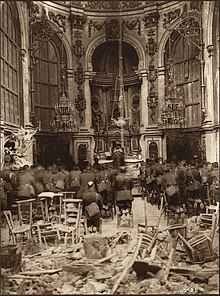| Cambrai Cathedral Cathédrale Notre-Dame-de-Grâce | |
|---|---|
 Cambrai Cathedral | |
| Religion | |
| Affiliation | Catholic Church |
| District | Archdiocese of Cambrai |
| Rite | Latin Rite |
| Ecclesiastical or organizational status | Cathedral |
| Location | |
| Location | Cambrai, France |
| Geographic coordinates | 50°10′20″N 3°14′0″E / 50.17222°N 3.23333°E |
| Architecture | |
| Type | Church |
| Style | Neoclassical |
| Groundbreaking | 1696-1703 |

Cambrai Cathedral (French: Cathédrale Notre-Dame de Grâce de Cambrai) is a Catholic church located in Cambrai, Nord, France, and is the seat of the Archbishop of Cambrai. The cathedral was registered as a monument historique on 9 August 1906.[1]
It was built between 1696 and 1703, on the site of a former 11th-century building, as the church of the Abbey of Saint-Sépulcre. During the French Revolution the old cathedral of Cambrai was destroyed, but the abbey church survived because it was used instead as a Temple of Reason. When the ecclesiastical status of Cambrai was restored in 1802, albeit as a diocese rather than as an archdiocese, which it had previously been, the bishop's seat was established in the surviving abbey church, which became the cathedral of Cambrai. Cambrai was again constituted an archbishopric in 1841.
The cathedral was severely damaged by fire in 1859, but at length restored, with advice from Viollet-le-Duc, and consecrated on 12 May 1894. It was raised to the status of a basilica minor by Pope Leo XIII on 17 March 1896.[2]
It was also badly damaged in World War I and, not so seriously, in World War II.
It contains the tomb, by David d'Anger, of François Fénelon, who was archbishop from 1696 to 1715. The Cathedral is a minor pilgrimage site because of the noted Italo-Byzantine painting known as the Cambrai Madonna or Our Lady of Cambrai (c. 1340) in a side chapel. The cathedral now takes its dedication name "Notre-Dame de Grâce" or "Virgin of Tenderness" from this painting, from the Eleusa icon type it exemplifies. In the same chapel is a memorial erected by Hilaire Belloc to commemorate his son who was killed nearby in the last days of World War I.
| Province of Besançon | |
|---|---|
| Province of Bordeaux | |
| Province of Clermont | |
| Province of Dijon | |
| Province of Lille | |
| Province of Lyon | |
| Province of Marseille | |
| Province of Montpellier | |
| Province of Paris | |
| Province of Poitiers | |
| Province of Reims | |
| Province of Rennes | |
| Province of Rouen | |
| Province of Toulouse | |
| Province of Tours | |
| Province of Martinique | |
| Province of Papeete | |
| Province of Noumea | |
| Directly under Holy See | |
| Ordinariate for Eastern Catholics | |
| See also | |
Basilicas of France | ||
|---|---|---|
| France |
| |
| International | |
|---|---|
| National | |
| Geographic | |